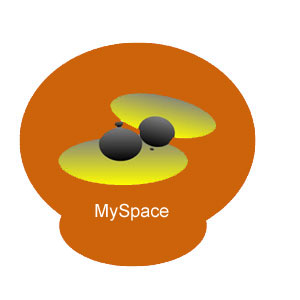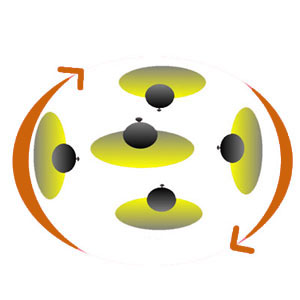Tango Navigation (Part I)
The Basics
Navigation is the ultimate tango skill. To do it well, you need to be aware of everything around you. You must be able to change direction instantly without losing your partner, your technique... or the music. Just like flying an airplane, the more hours you spend at it, the better you'll become. Over time, you'll begin to absorb thousands of micro-experiences that can't be taught, and like an experienced pilot, you'll begin to anticipate and respond to things that people with less experience might not even see.
I realize, however, that many people reading this don't have the opportunity to get in a thousand hours in crowded milongas—but that doesn't mean there's no hope. Let's look at a few things everyone can do to become competent at floor navigation. We'll begin with the simplest thing of all:
You Have to Want It
The first step toward good navigation is simply making a commitment not to bother other dancers. I know that can be hard to do, especially in places where a lot of people are dancing selfishly. I only began to dance carefully when I came to Buenos Aires. The milongueros were all so friendly and helpful that the idea of cutting them off or distracting them became distasteful to me, so I made a conscious effort to become a more polite and controlled dancer.
Putting limits on your dancing may not sound like fun, but it actually is. I didn’t realize it at first, but dancing more carefully made me much better. I began to express the music with more subtlety and richness. Let's jump back to the flying analogy: Anyone can go up in a plane on a clear day and do aerobatics. You can take a beginner up, and in half an hour teach him or her how to yank and bank through loops, wingovers, and rolls. But learning to fly with precision and control in order to do something like formation flying, or landing on an aircraft carrier, is a whole other world. In a sense, it's like good tango. You do less—that is, you don't yank and bank the plane around as much—but working within such strictly defined limits eventually becomes a hundred times more satisfying than just flying around in empty sky. So you might think of it this way: We don't want to be Bozo's who've learned how to do a few stunts, but can’t actually control an airplane. We want to seek out challenges. We want to be precise, professional aviators who know the limits and fly with control. Let's begin with three basic concepts.
1. Know how to use the 3 kinds of space on the floor.
2. The ronda has the right-of-way.
3. Drift counterclockwise, and "split the difference".
MySpace
(Or... Fun With Photoshop)
There are three basic kinds of space on the floor: Free Space, Shared Space, and MySpace. MySpace is the space you're entitled to dance in without worrying about anyone else. When it's very crowded, the space you and your partner "own" shrinks down to about this size:

This image shows the space a couple "owns" on a crowded floor. It gives them enough
room to take a small to medium step out and back in any direction, and do giros.
The figure above shows approximately the minimum amount of space you need to dance. It may expand a bit, depending on how crowded the floor is, but if it contracts more than this, it's time to sit down. Generally, you're entitled to enough space to do a medium length step (about 1.5 feet, or .5 meters) in any direction. You can step out and back and do giros without fear of touching anyone else with feet, legs, or arms. If someone else touches you when you're in your space, it's their fault, and they need to apologize. (The apology is normally a glance or nod acknowledging their mistake, which you accept by responding with a nod and a smile.)
Note that I added a little extra space to the spot directly behind the man. This doesn't necessarily mean you can take a bigger back step. I put it because this diagram not only shows the space you have, but just as importantly, it shows the space you need to give to other people—and it's best to give a little extra space to the blind spot directly behind other men on the floor.
Many academic couples like to dance "open embrace". They dance with space between them, or they dance close to each other, and then separate to do figures. Dancing separated is a controversial subject in tango, and I won't editorialize here—but strictly from an objective viewpoint, it's a selfish way to dance in a milonga. It takes up extra space, it inhibits the ability to make the quick changes of direction that are essential for good navigation, and it seems to encourage extended pausing for figures and poses. We've already discussed it at length, but here's a small diagram. The couple on the left is doing a giro in close embrace around a shared axis. The couple on the right is doing the the kind of giro often taught in workshops, with some chest separation, and the woman circling the man. The difference in the amount of space each couple uses may surprise you:


The couple on the left is doing a giro around a shared axis while maintaining chest contact.
The couple on the right is doing a typical classroom giro, with the woman circling the
man, and a foot of chest separation. The difference in the space used is striking.
The couple on the right is using almost four times as much floor space as the one on the left—and that's not even allowing for the extra space taken up by the leg sweeps that often accompany this kind of dancing! In good BsAs milongas, the floor is usually crowded, so it takes a pretty large dose of ego and ignorance to take away so much space from other couples.
The Ronda
as long as people know what they're doing."
-the milongueros
The ronda is the lane where dancers move counterclockwise around the perimeter of the floor. In most milongas it's right up against the tables, and the most important thing to know about it is that dancers in the ronda have the right-of-way.
Choosing to dance in the ronda is a trade off. You give up some space and freedom of movement for the security of a more controlled place to dance. Challenges of dancing in the ronda include watching out for men crossing from the other side of the floor to get their partners, people entering from between the tables, and waiters moving along the edge of the floor to deliver drinks. They all have the right to be there, and you need to be alert and share the space with them.
Why would anyone dance in the ronda when there may be more space in the center of the floor? I used to wonder about that. It takes more skill and control to dance well in the ronda, and part of the reason may be that good dancers simply enjoy the challenge. Also, I think the best dancers don't mind giving up a little extra space for the pleasure and security of dancing near other good dancers.
Here's what the ronda looks like from above, with couples moving along next to a row of blue tables:

The ronda, with "dawdlers" (couple 1) and "pushers" (couple 2).
The couples are moving from left to right—but there's a problem. Notice the wasted space between couple 1 and couple 2. This is caused by either a lagging couple (1), or a pushing couple (2). The rule for dancing in the ronda isn't complicated. In fact it's very simple: All you have to do is be aware of where the couples in front and behind are, and then split the difference!
Everyone in the ronda needs to gently drift forward, like jellyfish floating in the current. In addition, each couple can venture forward and backward within their space. They can move up close to the couple in front, or back toward the couple behind, but then they must return to the middle. The space between you and the couples in front or behind is "shared space". You can use it, but only when you're sure no one else is moving into it! It's yours for several beats (or maybe only one beat if your right up against someone). And not only can you use it, but you should use it—but then you must again split the difference between the couple in ahead and the couple behind, and return home to the center of your space.
The Squeeze Zone
The problem is that there always seem to be "pushers" and "dawdlers". When you think about it, what could be dumber? Why push the couple ahead of you in the ronda? Where are you going to go? And why refuse to move forward to the center of the space available to you? In both cases, you're hurting your own dancing along with everyone else's. You're not using all your space, and you're creating your own tight spot, with less freedom of movement, and more risk of contact. But the situation below is surprisingly common:

The Squeeze: The ronda with "pushers" (couple 1) and "dawdlers" (couple 2).
A pusher and a dawdler really mess things up. The pusher (couple #1) jams people up against the dawdler (couple #2), and even though the three couples caught in between are following the rules and splitting the difference, there's not much they can do—except escape to the middle of the floor (like I did last night). Being forced out of the ronda like this by bad dancers is common, and milongueros don't like it.
For me, it's more than a navigation issue. I just don't have the inner peace to ignore someone who stays right up behind me. It takes me out of my game. Rather than dreaming along with Vargas, I start thinking about sending a message, like taking a big step back onto the top of his stupid foot. And the guy who dawdles in the ronda is like a dog that keeps yapping until it finally brings you back from the edge of sleep. You start wondering, what the hell is this fool thinking? Why is he standing there doing all those ochos, instead of stepping into the three meters of empty space in front of him?
If everyone spaces themselves more or less evenly between the couple in front and behind, the ronda will work. The picture below shows how it should be done. I was able to add an extra couple to the diagram, making it a very crowded floor—but everyone still has enough room to dance comfortably:

This is how it's supposed to look. Note that nine couples are dancing here comfortably, instead
of the eight in the
first images. The spacing isn't perfect, because some couples have moved
a bit front or back—but they'll re-center themselves after a few beats.
On the next page we'll look at the entire floor, and discuss the different kinds of space available in a milonga.